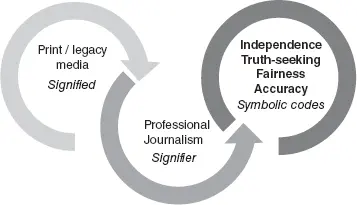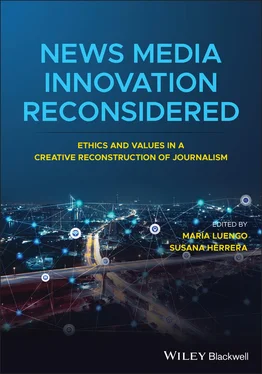
Figure I.1 The “Crisis in news narrative:” print/legacy media as meanings associated with professional journalism.
Digitalization broke this monopoly power. In the recent context of rapid technological change and economic upheaval, new digital ventures have proliferated, and the pace of change in the signifieds associated with them has accelerated. The continuous work of re-signification progressively places digital technologies on the side of journalistic standards. As Breese and Luengo (2016, p. 284) explain,
When blogs, Twitter, online-only news, live-streaming news, and other technologies enter newsrooms as new avenues for presenting news to the public, they tend to be greeted with anxiety. At first, mainstream journalists distance themselves from the technologies and related practices, dismissing them as antithetical to journalistic standards. Over time what had represented a threat to the news when it was “new” comes to successfully represent the civil codes of professional journalism.
Matthias Revers’s (2016) comparative analysis of how Twitter was adopted by journalists from the official press corps in New York and Bavaria shows the different ways in which digital media encounter specific journalism cultures “which draw from entrenched symbols and sacred discourses of journalism” (Revers, 2016, p. 231). Revers explains how these symbolic codes stand for boundary work that protects the journalistic profession against “competing occupations” as well as “deviant insiders.” He conceives the amalgamation of digital culture and professional journalism as a “cultural performance” (Alexander, 2004), “in which collective representations of professionalism provide the symbolic strength and substantive basis for scripts to act professionally in concrete situations” (Revers, 2016, p. 232).
This boundary process and cultural performance implies a symbolic struggle for newcomers to meet and assert journalistic standards so that they can be considered full players in themselves. New media have produced a discourse seeking to purify past negative characterizations that have positioned them as a threat to journalism. Thus, newly-founded ventures distance themselves from the polluting effects of the market and claims about the financial sustainability of their innovative business models. Once considered the cause of massive layoffs of journalists, falls in advertising revenues, drastic cuts in newsrooms, and other catastrophic consequences in the news business, digital technology is now presented as sustaining journalism. Online news start-ups, for example, have become for many the safety valve of journalism. Born-digital small companies successfully fill market niches of information, reaching where mainstream media cannot. The characterization of news websites, clicks, social networks, or web statistics has shifted from their being seen as sources of aggregative, superficial, sensational, and commodified news to their becoming tools for reporting original stories, breaking news, and conducting in-depth investigative journalism. Figure I.2 conveys this re-signification of the symbolic codes of professional journalism.

Figure I.2 The re-signification of professional journalism through new digital forms.
New Journalistic Performances on Stage: Ethics Vis-à-Vis Innovation
In Chapter 2, Ward offers the challenging notion of “democratically engaged journalism” to reconsidered journalism’s civil morals today. Ward contextualizes his conceptual proposal within a “toxic sphere of partisan, global media.” In many cases, digital technology has helped to feed our complex civil spheres with polarization and exclusion. In turbulent times of “irrational publics” (Ward, Chapter 2) and dizzying political shocks, the association of digital forms’ new meanings with the signifier of professional journalism must go through a cultural process in which moral values such as civil commitment, solidarity, social justice, dialog, and inclusion are highlighted (see Figure I.2). Contributions to this book show how, intermingled and reinforced by these civil and democratic values, truth seeking, fairness, independent reporting, and other enduring symbolic codes of journalism not only inspire new journalistic initiatives but also help to ensure journalism’s long-term survival.
The journalistic innovations examined in this book raise the value of engagement. In line with other recent studies on journalism’s immersive storytelling (Jones, 2017; Kukkakorpi and Pantti, 2020), Benitez, Pérez-Seijo, and Herrera ( Chapter 4) emphasize audience engagement as one of the specific characteristics that makes 360-degree video journalism disruptive and innovative, along with first-person experience, the illusion of presence, and empathy. However, as Benitez et al. show, to be successfully incorporated into journalistic practices and organizations, immersive journalism needs to reflect more than the audience’s emotional engagement. It needs to become civil engagement by the way in which narratives cathartically bring compassion and solidarity into the audience experience. Social connectedness goes beyond empathy, and the feeling for others and putting oneself in the place of another person represent more than a mere illusion of presence recreated by technological effects. To foster civil engagement, 360-degree immersive journalism must be based on credible stories that preserve the accuracy and integrity of spaces, images, and sounds and that are constructed using a careful search and selection of news sources. The case studies in this chapter show the way in which successful journalistic approaches to 360-degree news have been guided by professional codes of transparency, truthfulness, and responsibility.
Gómez-García and Martín - Quevedo’s Chapter 5reflects a similar tension between the audience’s emotional engagement and accurate reporting of the facts. The authors describe successful performances of new forms of interactive journalism that incorporate gameplay. These performances involve an ongoing cultural struggle against the immorality of playing with real-world events, deaths, and suffering. In this struggle, entertainment and triviality give way to the design of relevant social and political simulations that progressively include more investigative sources and perspectives. Stories based on biased, personalized objectives, which guide the gamer by targeting groups and individuals, turn into innovative newsgaming projects that ensure transparency and responsibility without losing the engaging and emotional dimension of gameplay.
New journalistic narratives may reflect how journalistic institutions are producing news in a more engaged way. In their analysis of “stamp story” formats, Navío-Navarro and González-Díaz ( Chapter 6) argue that this new way of disseminating the news helps to reach and engage with, for instance, Gen Z and Millennial audiences immersed in a digital culture, by maintaining journalism’s complexity and interpretation.
The use of big data has brought into journalism new ethical concerns in relation to transparency and the quality and bias of the data sets being used. These polluting effects of data available through digital technology, however, seem to have been partially overcome by some new forms of collaborative investigative journalism. Drawing on the metajournalistic discourses on the Panama Papers from different newspapers that investigated the leaked documents of Panamanian law firm Mossack Fonseca, Cortés and Luengo ( Chapter 7) observe that data journalists place themselves on an unpolluted side of new investigative reporting, in which, far from activism, data serve democratic-accountability journalism.
Читать дальше














